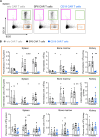CD19-targeting CAR T cells protect from ANCA-induced acute kidney injury
- PMID: 38182404
- PMCID: PMC10958264
- DOI: 10.1136/ard-2023-224875
CD19-targeting CAR T cells protect from ANCA-induced acute kidney injury
Abstract
Objectives: Anti-neutrophil cytoplasmic autoantibody (ANCA)-associated vasculitides (AAV) are life-threatening systemic autoimmune diseases manifesting in the kidneys as necrotizing crescentic glomerulonephritis (NCGN). ANCA antigens are myeloperoxidase (MPO) or proteinase 3. Current treatments include steroids, cytotoxic drugs and B cell-depleting antibodies. The use of chimeric antigen receptor (CAR) T cells in autoimmune diseases is a promising new therapeutic approach. We tested the hypothesis that CAR T cells targeting CD19 deplete B cells, including MPO-ANCA-producing B cells, thereby protecting from ANCA-induced NCGN.
Methods: We tested this hypothesis in a preclinical MPO-AAV mouse model. NCGN was established by immunisation of MPO-/- mice with murine MPO, followed by irradiation and transplantation with haematopoietic cells from wild-type mice alone or together with either CD19-targeting CAR T cells or control CAR T cells.
Results: CD19 CAR T cells efficiently migrated to and persisted in bone marrow, spleen, peripheral blood and kidneys for up to 8 weeks. CD19 CAR T cells, but not control CAR T cells, depleted B cells and plasmablasts, enhanced the MPO-ANCA decline, and most importantly protected from NCGN.
Conclusion: Our proof-of-principle study may encourage further exploration of CAR T cells as a treatment for ANCA-vasculitis patients with the goal of drug-free remission.
Keywords: Autoantibodies; Autoimmune Diseases; Granulomatosis with polyangiitis; T-Lymphocyte subsets; Vasculitis.
© Author(s) (or their employer(s)) 2024. Re-use permitted under CC BY-NC. No commercial re-use. See rights and permissions. Published by BMJ.
Conflict of interest statement
Competing interests: None declared.
Figures




Similar articles
-
Neutrophil Gelatinase-Associated Lipocalin Protects from ANCA-Induced GN by Inhibiting TH17 Immunity.J Am Soc Nephrol. 2020 Jul;31(7):1569-1584. doi: 10.1681/ASN.2019090879. Epub 2020 Jun 2. J Am Soc Nephrol. 2020. PMID: 32487561 Free PMC article.
-
CSF2-dependent monocyte education in the pathogenesis of ANCA-induced glomerulonephritis.Ann Rheum Dis. 2022 Aug;81(8):1162-1172. doi: 10.1136/annrheumdis-2021-221984. Epub 2022 Apr 13. Ann Rheum Dis. 2022. PMID: 35418479 Free PMC article.
-
Myeloperoxidase-specific plasma cell depletion by bortezomib protects from anti-neutrophil cytoplasmic autoantibodies-induced glomerulonephritis.J Am Soc Nephrol. 2011 Feb;22(2):336-48. doi: 10.1681/ASN.2010010034. Epub 2011 Jan 13. J Am Soc Nephrol. 2011. PMID: 21233415 Free PMC article.
-
New advances in the pathogenesis of ANCA-associated vasculitides.Clin Exp Rheumatol. 2009 Jan-Feb;27(1 Suppl 52):S108-14. Clin Exp Rheumatol. 2009. PMID: 19646356 Review.
-
Pathogenesis of ANCA-associated vasculitis: new possibilities for intervention.Am J Kidney Dis. 2013 Dec;62(6):1176-87. doi: 10.1053/j.ajkd.2013.05.009. Epub 2013 Jun 28. Am J Kidney Dis. 2013. PMID: 23810690 Review.
Cited by
-
Immune mediated inflammatory diseases: moving from targeted biologic therapy, stem cell therapy to targeted cell therapy.Front Immunol. 2025 Apr 7;16:1520063. doi: 10.3389/fimmu.2025.1520063. eCollection 2025. Front Immunol. 2025. PMID: 40260258 Free PMC article. Review.
-
Characterizing the Real-World Risks of Kidney Injuries Associated with Chimeric Antigen Receptor T Cell Therapies-Evidence and Safety.Health Data Sci. 2025 Sep 2;5:0325. doi: 10.34133/hds.0325. eCollection 2025. Health Data Sci. 2025. PMID: 40904688 Free PMC article.
-
CAR-T therapy: pioneering a new era in the treatment of autoimmune diseases.Front Immunol. 2025 Aug 13;16:1625166. doi: 10.3389/fimmu.2025.1625166. eCollection 2025. Front Immunol. 2025. PMID: 40881712 Free PMC article. Review.
-
CAR T cell therapy for children with rheumatic disease: the time is now.Nat Rev Rheumatol. 2025 Aug;21(8):494-506. doi: 10.1038/s41584-025-01272-3. Epub 2025 Jul 2. Nat Rev Rheumatol. 2025. PMID: 40603629 Review.
-
Current progress in CAR-based therapy for kidney disease.Front Immunol. 2024 Aug 20;15:1408718. doi: 10.3389/fimmu.2024.1408718. eCollection 2024. Front Immunol. 2024. PMID: 39234257 Free PMC article. Review.
References
MeSH terms
Substances
LinkOut - more resources
Full Text Sources
Medical
Research Materials
Miscellaneous

